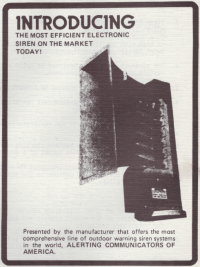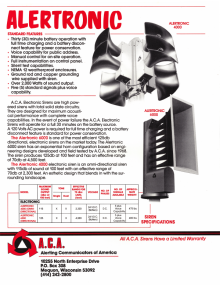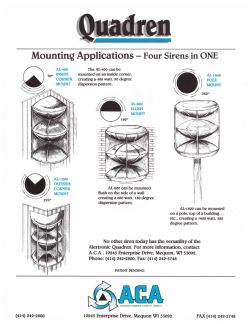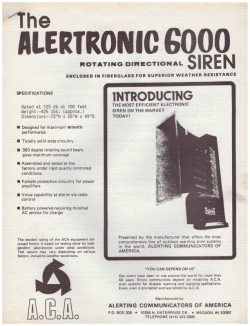Alertronic
| Alertronic | |

| |
| Company | |
|---|---|
| Produced | 1983-2011 |
| Type | |
| Sound output | 108-128 dB @ 100 ft |
| Wattage | 400-4800 W |
| Voltage | 24 V DC |
The Alertronic series was a line of fully electronic, voice and tone, directional and omnidirectional sirens produced by Alerting Communicators of America, and later American Signal Corporation beginning in the early 80s and lasting through the early 2010s.
History

The Alertronic series was introduced in 1983 as ACA's first fully electronic warning system. The original purpose of these sirens was to give ACA a chance to compete in the market against Whelen's popular WS-2000/3000 and Federal Signal's EOWS series of sirens. The first 2 sirens introduced were the AL-4000, which was a directional electronic siren made up of 4 speaker arrays, and the AL-5000, which was a rotational, high powered electronic siren. While the AL-4000 proved popular, the AL-5000 would be a complete failure and would be discontinued shortly after.
In 1985, the AL-6000R was released, which was a rotational electronic siren that was meant to replace the 5000. It used a design that was very similar to the WS-3000, which nearly led to a lawsuit from Whelen, though the lawsuit was dropped as ACA was deemed to not be a significant enough competitor. The same year, the short-lived omnidirectional AL-7200 would be released. These 3 sirens would be the only sirens in the series until 1986, when the AL-1000, AL-2000, AL-6000, and AL-8000 would be released, which were variations of the AL-4000 with differing amounts of speakers. The line would remain the same until 1991, when the AL-6000R would be discontinued and replaced by the AR-1600, which was an improved version of the design with better performance and cheaper production and maintenance costs.
In 1992, the Quadren would be introduced, which was considered part of the Alertronic series at that point in time. In 1994, ACA went bankrupt and was bought by HÖRMANN, being reformed into ASC. The Alertronic line would remain largely the same as it was, though in 1994 the Quadren would be renamed to the i-FORCE, and the AR-1600 would be renamed to the RE-1600. The line would remain unchanged throughout the rest of its production, until the line was finally discontinued in 2011. Today, Alertronic sirens are few and far between, both due to their poor sales compared to their competitors, as well as the increasing age of these sirens. These sirens developed a reputation for questionable reliability, with some cities opting to replace them entirely after a few years. Enthusiasts have also noted their quietness compared to other electronic sirens, which may be due to failing drivers as these sirens age. Few rotational Alertronics remain in service, along with a handful of directional units. Others sit abandoned and rotting away, having been replaced or decommissioned long ago.
All Alertronic sirens run on 24 V DC, and are capable of battery backup operation, allowing for the siren to operate for up to 30 minutes after main grid power is lost. The siren can run on either deep cell 24 V batteries, or on solar powered operation. Alertronics are capable of 10 main signals, with 13 different programmable tones. These signals were Alert, Attack, Fire, Airhorn, Hi-Lo, Hazard, Scream, Wail, Silent Test, and Chimes, and all Alertronic sirens are voice-capable, using either a live microphone on the controller, or prerecorded messages. The sirens can run on analog or digital controllers.
Models
Directional
AL-1000
The AL-1000 is a directional electronic siren, which is essentially an AL-4000 cut in half. It makes use of 4 Atlas CJ-46 fiberglass paging horns attached to a rectangular aluminum housing which contains the wiring and speaker drivers. The AL-1000 uses 4 100 W speaker compression drivers, with one attached to each horn, for a total of 400 W. There is a removable panel on one side of the siren, which allows access to the internals. The design of the AL-1000 allowed for different directional configurations by removing speakers on one or more sides. The AL-1000 reaches 108 dB at 100 ft.
AL-2000
The AL-2000 is a directional electronic siren, which is essentially an AL-4000 cut in half. It makes use of 4 Atlas CJ-46 fiberglass paging horns attached to a rectangular aluminum housing which contains the wiring and speaker drivers. The AL-2000 is visually identical to the AL-1000, but differs on the inside by doubling the number of drivers, with 2 100 W drivers per horn for a total of 800 W. There is a removable panel on one side of the siren, which allows access to the internals. The design of the AL-1000 and AL-2000 allowed for different directional configurations by removing speakers on one or more sides. The AL-2000 reaches 112 dB at 100 ft.
AL-4000
The AL-4000 is a directional electronic siren, and was advertised as a cheaper alternative to the Alertronic 5000 when it was first released. The AL-4000 is a simple electronic siren, with 8 Atlas CJ-47 fiberglass paging horns attached to a cubical aluminum housing which contains the wiring and speaker drivers. The AL-4000 was available without the square housing, with each speaker array's drivers being contained in individual smaller housings. This made it able to face in more than 4 directions, and made it look very similar to a DSA or WS-2000. The AL-4000 contains 16 100 W speaker drivers, with two attached to each horn for a total of 1600W. There are 2 horns on each side of the housing. There is a removable panel on one side of the siren, which allows access to the internals, and the design of this siren allowed for different directional configurations by removing speakers on one or more sides. The AL-4000 reaches 116 dB at 100 ft.
AL-6000
The AL-6000 is directional electronic siren, essentially being an AL-8000 with the top 4 speakers removed. It shares the same housing as the AL-8000 to save on costs. Due to this, the horn mounts are visible where the horns would have been mounted. The AL-6000 makes use of 12 Atlas CJ-46 fiberglass paging horns attached to a tall rectangular aluminum housing, with three horns on each side. The siren used 2 100 W speaker compression drivers per horn, for a total of 2400 W. There is a removable panel on one side of the siren, which allows access to the internals, and the design of this siren allowed for different directional configurations by removing speakers on one or more sides. The AL-6000 reaches 121 dB at 100 ft.
AL-8000
The AL-8000 is the largest directional siren in the Alertronic series, essentially being two AL-4000s stacked on top of each other with a single rectangular housing. The AL-8000 shares the same housing as the AL-6000 which contains the siren's wiring and drivers, with 16 Atlas CJ-46 fiberglass paging horns attached to the housing, 4 horns being on each side. The siren uses 32 100 W speaker compression drivers, with 2 drivers attached to each horn, for a total of 3200 W. There is a removable panel on one side of the siren, which allows access to the internals, and the design of this siren allowed for different directional configurations by removing speakers on one or more sides. The AL-8000 reaches 126 dB at 100 ft.
Omnidirectional
AL-7200
The AL-7200 is a omnidirectional electronic siren. Little is known about this siren compared to the rest of the series, as it was relatively short lived. It uses an omnidirectional design compared to the directional design the other non-rotational sirens used. The AL-7200 uses the same Atlas CJ-46 paging horns as the other sirens, with 3 rows of 8 horns attached to an octagonal aluminum housing which contains the speaker drivers and wiring, with a total of 24 horns altogether. The siren is assumed to use 48 100 W speaker compression drivers, with two attached to each horn, for a total of 4800 W. A larger 30-speaker model, the AL-12000, was rumored to have existed, though no evidence of this siren's existence has been found. The siren's decibel rating is unknown.
Quadren

Main article: ASC i-FORCE
The Quadren is an omnidirectional electronic siren that differs significantly from the other Alertronic sirens in design, being a large stacked-cell electronic siren similar to a Federal Signal Modulator or Whelen WPS-2800. While similar in appearance, its internal design is completely different, with the Quadren only having speaker compression drivers in every other cell. The sound is projected out of both the top and bottom of each active cell using horns inside the cells. Each active cell has half of a dummy cell on the top and bottom which forms an entire dummy cell in between each active cell when stacked, which forms the projectors through its shape. Like all of ACA's sirens, the cells are made of weather and corrosion-resistant fiberglass. Each active cell quadrant has a removable panel to easily access and replace faulty drivers.
Each active cell in a Quadren is formed by four separate quadrants, which when 4 of them are put together form an entire cell. Each quadrant contains 4 100 W speaker compression drivers, meaning that a fully formed cell with 4 quadrants will have 16 100 W drivers. The siren was designed in a way where it could be cut in half or even in quarters to be mounted on walls or corners, instead of just on a pole. This made them more versatile, and they could be installed just about anywhere. None of these wall or corner mounted Quadrens are known to have been installed or exist today. Up to 3 active cells were supported per siren, for a maximum of 4800 W. A smaller variant was also available, which only had one horn channel and produced sound from only the bottom of the active cell. This made the siren far more compact. Quadren models were given the "Q-XXXX" designation (XXXX being the wattage) and the three main models sold were the Q-1600, Q-3200, and the Q-4800. No Q-4800 models are known to exist.
Rotational
AL-5000
The AL-5000 is a rotational electronic siren that makes use of a large fiberglass projector consisting of 6 exponential channels that came together into one large projector. Each channel is connected to two 100 W drivers for a total of 1200 W. Supposedly, the design was later altered to include 4 100 W drivers per channel for a total of 2400 W. The assembly utilized a chain-driven rotator that allowed the horn assembly to rotate 360°. Due to the siren's design, it was susceptible to falling over due to high winds, which made it rather unpopular. Like the rest of the Alertronic family, it likely made use of collector rings. The AL-5000 reaches at 125 dB at 100 ft. The AL-5000 was never a popular siren, and only a handful were ever confirmed to exist. It is extinct today. The reasons were likely due to its oversized projector which was susceptible to wind damage, as it acted like a sail. High winds could damage the projector, or the rotation mechanism. ACA found inspiration in Whelen's WS-3000 and designed the AL-6000R, which quickly replaced the AL-5000.
AL-6000R

The AL-6000R is a rotational electronic siren, utilizing high-powered speaker drivers located in the back panel of the siren to amplify the sounds from the controller. The AL-6000R uses 16 100 W drivers for a total of 1600 W, with two drivers paired into each of the siren's 8 "throats" which connect to the siren's singular horn and allows the siren to reach 125 dB at 100 ft. The siren is rotated with a separate motor and gear reduction drive which drives a chain inside of the lower enclosure that rotates the entire siren unit 360°. Early AL-6000Rs made use of the Allertor/Penetrator series chain-driven rotators, although facing backwards. This was quickly changed to an internal chain-driven rotator to shield it from corrosion, which is the design it used up until its discontinuation.
Every other rotating Alertronic siren used this rotator afterwards. Like Federal Signal's EOWS series, the AL-6000R makes use of collector rings, which means it doesn't have to oscillate. However, this also means that the siren may cut out or glitch if the rings are dirty. For a short time, ACA experimented with directly wired drivers, removing the collector rings and hard wiring the drivers to the controller and adding a reverser switch to allow the siren to oscillate like a Whelen. At least one of these units survives in private possession. The siren's overall design was similar enough to Whelen's WS-3000 that Whelen considered suing ACA for infringing on their designs, but they chose not to as ACA was not deemed a big enough competitor in the electronic siren market.
AR-1600/RE-1600
The AR-1600 is a rotational electronic siren, and was introduced as an improved and refined version of the previous AL-6000R. The siren uses largely the same design, with a few changes. The number of throat channels was reduced from 8 to 4, with the siren using 16 100 W speaker compression drivers, with 4 attached to each throat. In addition, the siren's aluminum components were replaced with corrosion-resistant fiberglass components, and a mesh screen was added to the siren's projector to help keep debris out of the throats.
The siren's overall height was slightly reduced, with the projector now being more compact due to having fewer throat channels. The projector itself was simplified, with a shorter distance from the end of the throats and the end of the projector itself, and the length of each throat is longer than the AL-6000R. The driver cover on the rear is now rounded on the top and bottom. All of these changes improved the siren's performance, with the siren reaching 128 dB at 100 ft. The AR-1600 would be renamed to the RE-1600 in 1994 when ACA became ASC. The siren's overall design was similar enough to Whelen's WPS-4004 that Whelen considered suing ACA for infringing on their designs, but they chose not to as ACA was not deemed a big enough competitor in the electronic siren market.